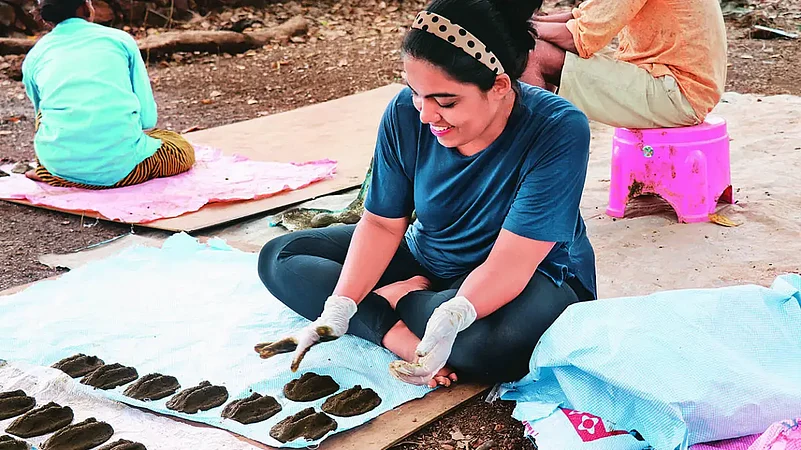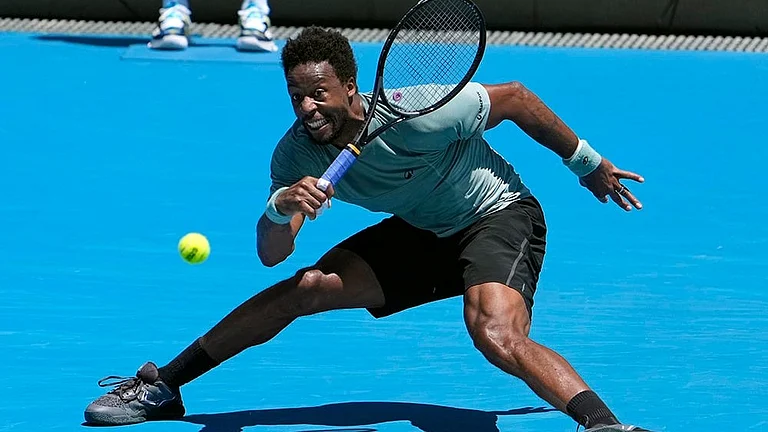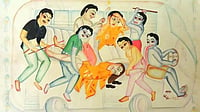Close to 300 sculptures of the vulva arranged in a dotted grid occupy a wall at the ongoing Berlin Biennale. The setup feels regimental, like soldiers in a battalion. Not a step out of line. All identical; almond-shaped, palm-sized, vertical lips and hollow openings.
The display by artist Mayuri Chari from her ongoing series, I Am Not Created for Your Pleasure, harks to regressive patriarchal norms that dictate what a woman must wear, eat, say, and do, and in time, turn her into a mere puppet, ashamed of her body, her sexual desires. The yonis (Sanskrit: vulvas), symbolic of Shakti, shaped from cow dung, question societal norms that allow animal excreta as fuel in the puja room but stop a menstruating woman from accessing the same space. Her bold defiance and fresh ways of portraying women, their bodies, and raw sexuality, have brought this young emerging artist to the limelight. Mass-produced forms and repetitive patterns have become her visual aids to present gender discrimination and disparity among the weaker sex, women.
The artist, who shuttles between Goa and Mumbai as home, belongs to the Vishwakarma community, who, albeit part of OBCs (Other Backward Castes), practices a few Brahminic purification/cleansing rituals.
A menstruating woman is seen as capable of ‘polluting’ any person or thing she touches. Before intervention from progressive relatives and her own decision to boycott these restrictions, Chari was confined to one corner at home when on her periods. She could not attend events, had to only use the back door, hide in case of visitors, wash her used items separately, etc. While the men never interfered, her mother was the staunch custodian of this patriarchal morality.
The final push came during her Master’s in Painting at SN School of Art, Hyderabad Central University, when Chari presented a few self-imprints of her body in class. The shame and ridicule from peers made her understand the limits of self-expression a woman is allowed. Instead of disappointment, she conducted a survey, questioning colleagues about their perceptions of the female body, menstruation, etc. Most ‘respondents’ stayed tight-lipped, which irked Chari into writing her first poem, Monologue of the Vagina—Are You Ashamed Of Me?
Opposition to her art is rife even today. Much like the reactions to exposed genitalia in art history—strategically placed drapery to vandalism—hours before the opening of her show at a Mysore gallery this year, Chari was asked to de-install a work showing three nude women. Instead, she covered the work with a cloth and stuck a note on it that cautioned: ‘Don’t open, I’m nude inside’. The work was also rejected by a museum in Mumbai, citing nudity. “But I am showing it at the Berlin Biennale, without a curtain,” says the 30-year-old.
Chari’s mother’s saris have become a canvas for her stitched vocabulary. Two works—Mein Ghar Tak Hi Seemit Hoon (A Woman Is Limited To The Home), a line stitched in 16 Indian languages as a counterstatement to feminist ideals, and Arise, Awake and Educate, Smash Traditions—Liberate, the motto by 19th-century reformist Savitribai Phule—stand out. “I made it for my mother, who did not perform the shuddhikaran (purification ritual) after my father’s passing away and is still barred from the kitchen and mandir on ‘auspicious’ events.”
Not all inherited traditions are in vain. She attributes her experiments in cow dung and trousseau embroidery to learnings from her mother during school vacations. “‘Otherwise, what will your mother-in-law say?’ my mother would say. Mastering these skills was her way of becoming independent, but only skills that made others happy. However, even I create only for the masses, and make them easy to comprehend, nothing highly conceptual.”
(This appeared in the print edition as "Vulvas in Cow Dung and Other Stories")
Liked the story? Do you or your friends have a similar story to share about 'ordinary' Indians making a difference to the community? Write to us. If your story is as compelling, we'll feature it online. Click here to submit.


























